By Stephanie Fong
Photos by Rachael Neva Photo
The American naturalist and author Enos Mills wrote, “Within National Parks is room — glorious room — room in which to find ourselves, in which to think and hope, to dream and plan, to rest and resolve.” His words seem to be written for Wendy Ross, a woman whose entire life is virtually woven into the fabric of our national parks.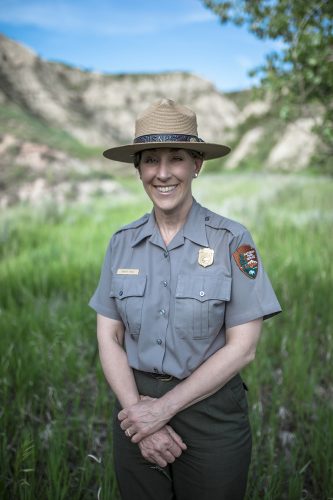
Wendy, the superintendent of Theodore Roosevelt National Park since 2015, regularly immerses herself into the glorious room that is the North Dakota Badlands to recharge her batteries, ponder her challenges, and grow her dreams for the national park under her care.
BORN INTO SERVICE
Wendy has been surrounded by the beauty of our national parks her entire life — her father was a climbing ranger at Mount Rainier National Park near Tacoma, Washington, when she was born. From there, her father’s career took the family to Grand Teton, Yosemite, and eventually Cape Cod National Seashore. When her parents relocated to the Great Smoky Mountains toward the end of her high school career, she was allowed to stay with family friends at Cape Cod through graduation. Whatever park she and her family were living at, volunteering within the parks was a big part of her youth.
“I volunteered through all of my high school years,” Wendy shares.
She participated in such projects as beach grass revegetation and fish studies for anoxic conditions.
“Anything that was a scientific research paper or project, I was involved in,” Wendy says.
In a time when national park employees were more often male than female, two strong female mentors, both resource management specialists, helped spark her interests and inspire career goals.
“They really showed me how cool it was to get outside and get dirty and do things like trap mosquitoes for different disease testing or look at Lyme disease on Cape Cod,” Wendy says.
Her natural scientific tendencies and childhood experiences led her to major in arctic and alpine biology at Middlebury College in Vermont. After graduation, she began a lifelong career in government service. First, with a two-year commitment to the Peace Corps in Sri Lanka followed by 25 years (and counting) with the national park service.
Starting at the entrance station at Yellowstone National Park, she grew her experience and responsibilities at each new park she was assigned — from Shiloh National Military Park to North Cascades National Park, from Glacier National Park to Knife River Indian Villages National Historic Site, and eventually Theodore Roosevelt National Park.
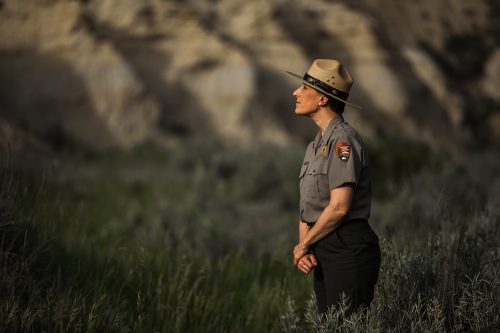
She smiles at the thought of her work out in the field in her earlier assignments.
“I’d do so much hiking. I love to be outside. At North Cascades, I was doing grazing studies out on backcountry trails, flood studies, and large-scale landform mapping.”
Even her memories of national events are shaped by where the parks have taken her.
“I was actually in the wilderness of North Cascades for a week, and 9/11 happened. We were in the flyway between Seattle and Minneapolis, and you would see contrails constantly when we’d be out camping, and all of a sudden, no airplanes. It was the most surreal thing. Silent. We came out of the back country a week later, and my husband met us at the trailhead and told us what happened. We had no clue.”
COMING FULL CIRCLE
During her college years, Wendy’s father became the superintendent at the Theodore Roosevelt National Park (TRNP). From 1990-1995, he lived and worked in Medora, North Dakota.
After her junior year of college, raw from a breakup with a boyfriend, Wendy spent the summer in Medora hiking and biking the Badlands.
“I healed my broken heart, volunteered in the park, and had a great time,” she recalls with a chuckle.
Life moved on, and so did she — growing her career and moving up in levels of responsibility. Some 25 years later, she was thrilled to be named superintendent of Theodore Roosevelt National Park, a place she sees as a true treasure and a source of endless possibilities.
Having lived and worked in so many of our national parks, TRNP still stands out to Wendy as uniquely wonderful.
She points out one of her favorite wonders as the sudden change from grassland to Badlands near the Painted Ca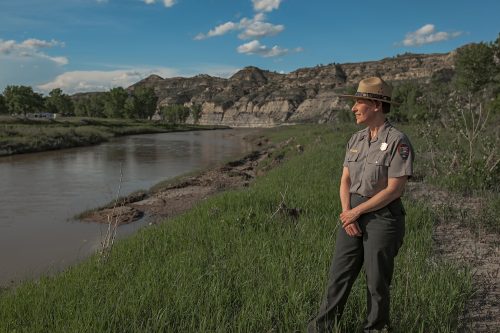 nyon Visitor Center along Interstate 94.
nyon Visitor Center along Interstate 94.
“That drive from Dickinson into the Badlands — for me, every time, ‘falling off the edge of the earth’ there into the Badlands — is one of the experiences that never fails to surprise me.
“Here, the landscape is constantly in motion. It is constantly changing. You never know what you’re going to encounter,” Wendy adds.
She also knows how valuable and unique the lack of crowding is for TRNP and its visitors. While many of the park’s 700,000+ annual visitors traditionally drive the paved loop, Wendy recommends a different route.
“I would encourage people to get off the beaten path, either on a trail or off a trail, because this is one of the few parks in which you can actually go off trail. You can go with horses; you can hike,” Wendy says. “You come over horizons and you encounter scenery and you wonder when the last time people last saw that.”
She describes winter as an incredible time to visit the park.
“People think we’re closed in the wintertime, but we’re open all year, 24/7. One of my favorite things to do is to ski on the river with two inches of snow on the (frozen) river — that’s all you need on the river to ski.”
Asked if she has a favorite spot to visit in TRNP, her eyes light up as she declares, “I really don’t! Every day, every condition, every different kind of light — it’s all magical. And it extends for me to the larger Badlands area outside the park. There’s a lot of country to get lost in, and there’s so much history here.”
A SEED-PLANTER OF IDEAS
There is something about Wendy that shows she is completely comfortable in her own skin. As she approaches her 50th birthday this fall, she says she loves the place she is in her life.
“When I was in grade school, maybe 8 or 9 years old, I had these goals in my life: to go to Middlebury College, become a resource management specialist in the national park system, go to Alaska, and go into the Peace Corps, and I did all of those things before I was 30. It was really goal-oriented up until then.
“I’ve definitely evolved. I’m dream-oriented,” Wendy says. “I love to think about the big picture. I’ve come into this place in my life where I love to move to new places and look at huge-scale — I’m talking ecosystem-scale — possibilities. ‘What can be done in this place that has never been done before and what is something that is so universally huge that nobody else would even think about going there?’ Those are the kinds of challenges that move me now.”
Wendy didn’t always dream of being a park superintendent, but her excitement for relationship-building, the art of listening, and showing respect to everyone has naturally led her into a leadership role.
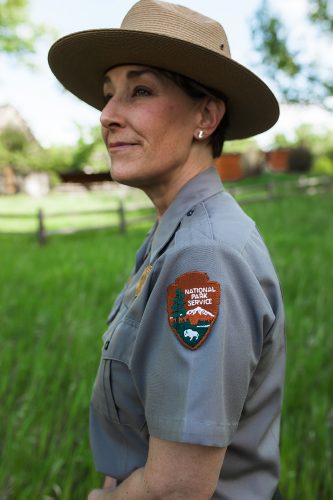
As superintendent, Wendy is tasked with taking care of the park’s resources, taking care of her staff, and leveraging the park’s partnerships.
She considers herself a seed-planter of ideas, giving the framework and encouragement to the many entities at play in Western North Dakota to create a future that benefits everyone.
“Western North Dakota is an ecosystem of recreation and resource protection,” Wendy says. “With the energy industry poised to produce two million gallons per day, and the communities having grown the way they have grown — Dickinson, Williston, Watford City, even Medora — I feel that Western North Dakota is in this place where we can rethink our relationship with the earth and how we recreate with the earth, how we use the earth, how we live in communities and how we expand our values to the larger ecosystem. TRNP is right at the core of that, as a core protected area.”
Wendy recognizes the value each cultural and economic group brings to our region.
“There are various different uses outside of our core protected area that are all relevant, all necessary, all exciting. And there’s so much collaboration potential there that if we all worked in different ways, I think we could have a model in Western North Dakota that’s not been seen anywhere else in the world.”
CHALLENGES IN TODAY’S NATURAL PARKS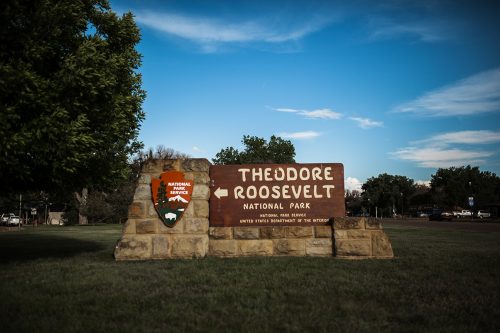
With three distinct units and 70,000 acres, challenges facing Wendy and other park leadership today range from the practical to the big-picture. They plan long-term solutions for issues like managing genetic diversity within their bison population, proactively anticipating what chronic wasting disease could do to the elk herd and park resources, and working with an erosive landscape (an example just this year is having to close off a portion of the park loop drive due to the massive slumping that destroyed a stretch of road.)
But, from Wendy’s big-picture mindset, the biggest challenge today is successfully reconciling the dual mission of the national park service.
“The National Park Service was created to protect and preserve the natural and cultural resources for this and future generations,” Wendy explains, “So, there’s a resource protection mandate, and it’s for the benefit and enjoyment of the people.”
Part of her role at TRNP, then, is constantly assessing and analyzing what the public wants, whether that means more hikeable trails, more ranger-led programs, or more collaborations with community organizations and educational institutions.
And beyond what people say they want in surveys, Wendy also reflects on what people deeply need that our national parks can offer.
“Fundamentally, whether they know it or not, people are looking for the same exact same thing. They’re looking for a beautiful place. They’re looking for an experience they’ve never had before in a place that’s a little outside of their comfort zone, whether that’s going on a mile hike when you don’t usually hike, or going on a really strenuous backpacking trip.
“But I think people are also looking for solace — a place to lose oneself.”
